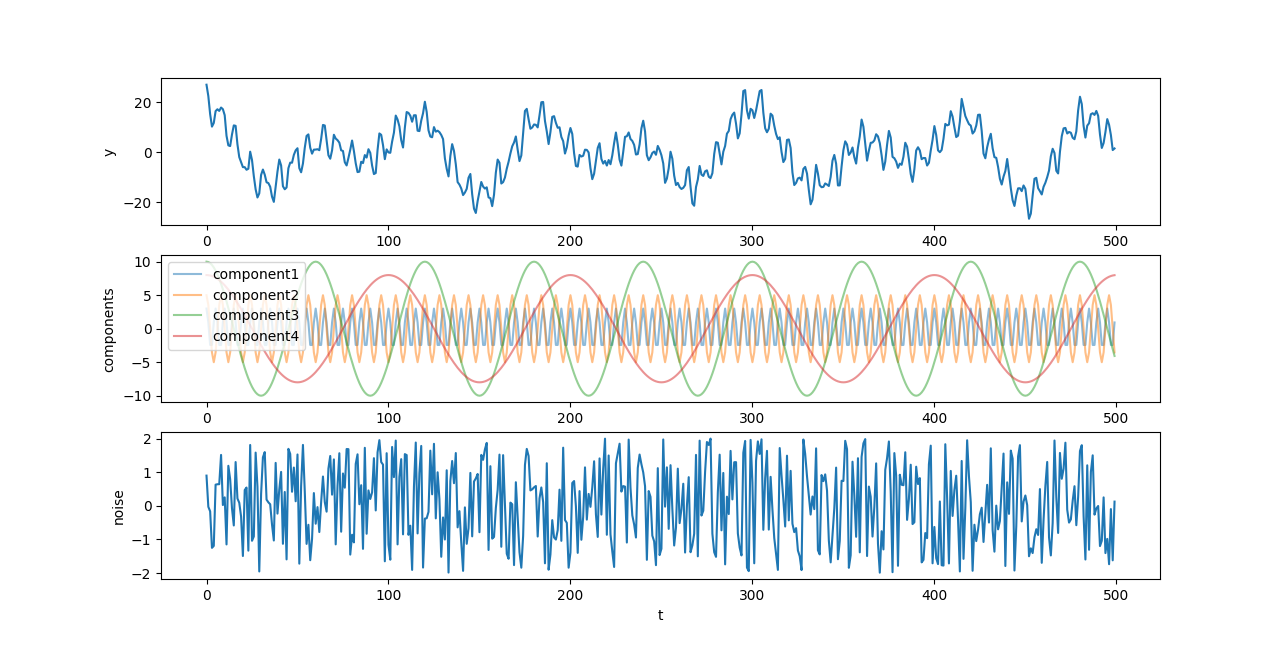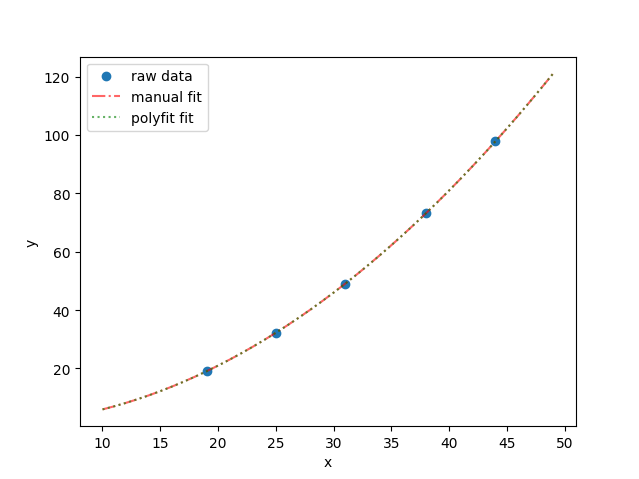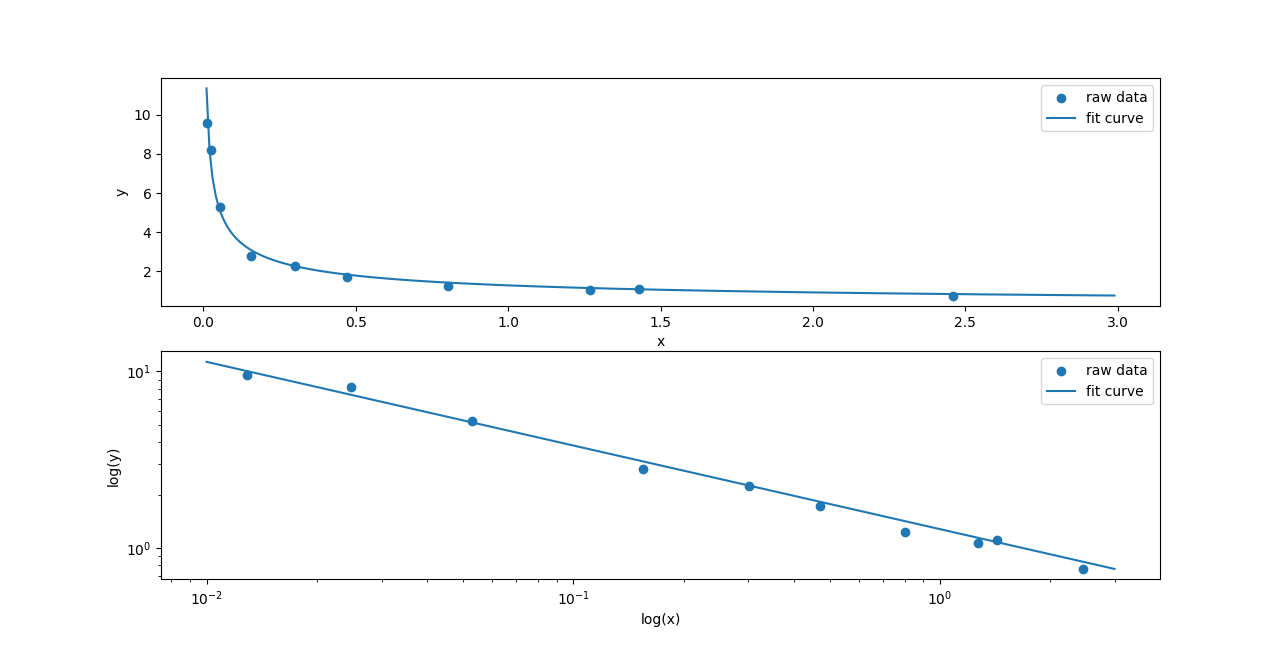作业二
韦境量
T1:构造时间序列
构造时间序列,至少包含五种成分和噪声,要求至少含有四个周期项
编写python代码如下:
py
import numpy as np
import matplotlib.pyplot as plt
# create data
T1 = 5
T2 = 8
T3 = 60
T4 = 100
x = np.arange(0, 500, 1)
def create_data(x):
component1 = 3 * np.cos(2 * np.pi / T1 * x)
component2 = 5 * np.cos(2 * np.pi / T2 * x)
component3 = 10 * np.cos(2 * np.pi / T3 * x)
component4 = 8 * np.cos(2 * np.pi / T4 * x)
noise = np.random.uniform(-2, 2, len(x))
all = component1 + component2 + component3 + component4 + noise
return all, component1, component2, component3, component4, noise
y, y1, y2, y3, y4, noise = create_data(x)
# draw
ax1 = plt.subplot(311)
ax2 = plt.subplot(312)
ax3 = plt.subplot(313)
ax1.plot(x, y)
ax1.set_ylabel('y')
ax2.plot(x, y1, alpha=0.5, label='component1')
ax2.plot(x, y2, alpha=0.5, label='component2')
ax2.plot(x, y3, alpha=0.5, label='component3')
ax2.plot(x, y4, alpha=0.5, label='component4')
ax2.set_ylabel('components')
ax2.legend()
ax3.plot(x, noise)
ax3.set_ylabel('noise')
ax3.set_xlabel('t')
plt.show()1
2
3
4
5
6
7
8
9
10
11
12
13
14
15
16
17
18
19
20
21
22
23
24
25
26
27
28
29
30
31
32
33
34
35
36
37
2
3
4
5
6
7
8
9
10
11
12
13
14
15
16
17
18
19
20
21
22
23
24
25
26
27
28
29
30
31
32
33
34
35
36
37
创建4个周期成分和一个均匀随机分布在

T2:最小二乘法拟合数据
用最小二乘法以
理论推导
待拟合数据
要得到能使残差平方和
将上式分别对参数
当
上面二式化简为
解得
编写程序
编写python代码如下:
py
import numpy as np
import matplotlib.pyplot as plt
# raw data
xi = np.array([19, 25, 31, 38, 44])
yi = np.array([19.0, 32.3, 49.0, 73.3, 97.8])
# find the least squares best fit line of the form y = a + bx^2
sum_x2 = 0
sum_x4 = 0
sum_y = 0
sum_x2y = 0
n = len(xi)
for i in range(n):
sum_x2 += xi[i]**2
sum_x4 += xi[i]**4
sum_y += yi[i]
sum_x2y += xi[i]**2 * yi[i]
a = (sum_x4 * sum_y - sum_x2y * sum_x2) / (n * sum_x4 - sum_x2**2)
b = (n * sum_x2y - sum_x2 * sum_y) / (n * sum_x4 - sum_x2**2)
x_fit = np.arange(10, 50, 1)
y_fit_manual = a + b * x_fit**2
# use polyfit to confirm
xi2 = xi**2
an = np.polyfit(xi2, yi, 1)
p = np.poly1d(an)
y_fit_polyfit = p(x_fit**2)
# draw
plt.scatter(xi, yi, label='raw data')
plt.plot(x_fit, y_fit_manual, 'r-.', alpha=0.6, label='manual fit')
plt.plot(x_fit, y_fit_polyfit, 'g:', alpha=0.6, label='polyfit fit')
plt.xlabel('x')
plt.ylabel('y')
plt.legend()
plt.show()1
2
3
4
5
6
7
8
9
10
11
12
13
14
15
16
17
18
19
20
21
22
23
24
25
26
27
28
29
30
31
32
33
34
35
36
37
38
39
2
3
4
5
6
7
8
9
10
11
12
13
14
15
16
17
18
19
20
21
22
23
24
25
26
27
28
29
30
31
32
33
34
35
36
37
38
39
先使用理论推导中得到的参数公式进行计算,然后再用numpy模块自带的polyfit进行验证,绘图如下

T3:曲线拟合并绘制对数图
用
编写python代码如下:
py
import numpy as np
import matplotlib.pyplot as plt
from scipy.optimize import curve_fit
# raw data
xi = np.array([0.0129, 0.0247, 0.053, 0.155, 0.301,
0.471, 0.802, 1.27, 1.43, 2.46])
yi = np.array([9.56, 8.1845, 5.2616, 2.7917, 2.2611,
1.734, 1.237, 1.0674, 1.1171, 0.762])
# use curve_fit to fit
def func(x, a, c):
return a * x ** c
popt, pcov = curve_fit(func, xi, yi)
x_fit = np.arange(0, 3, 0.01)
y_fit = func(x_fit, popt[0], popt[1])
# draw
ax1 = plt.subplot(211)
ax1.scatter(xi, yi, label='raw data')
ax1.plot(x_fit, y_fit, label='fit curve')
ax1.set_xlabel('x')
ax1.set_ylabel('y')
ax1.legend()
ax2 = plt.subplot(212)
ax2.scatter(xi, yi, label='raw data')
ax2.plot(x_fit, y_fit, label='fit curve')
ax2.set_xscale('log')
ax2.set_yscale('log')
ax2.set_xlabel('log(x)')
ax2.set_ylabel('log(y)')
ax2.legend()
plt.show()1
2
3
4
5
6
7
8
9
10
11
12
13
14
15
16
17
18
19
20
21
22
23
24
25
26
27
28
29
30
31
32
33
34
2
3
4
5
6
7
8
9
10
11
12
13
14
15
16
17
18
19
20
21
22
23
24
25
26
27
28
29
30
31
32
33
34
使用scipy模块中的curve_fit函数进行拟合,绘图如下 